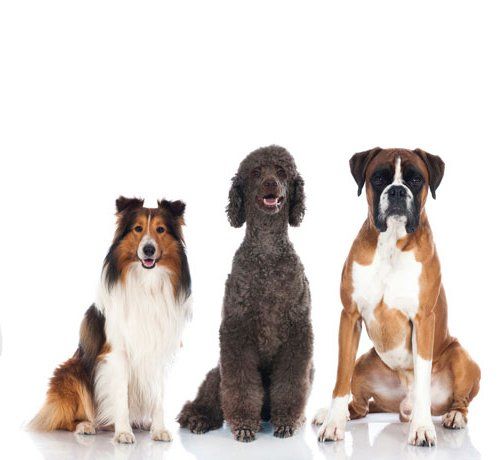INTRODUCING NEW DOGS
Introducing a new dog to other dogs or into a home that already has a dog can be easy if you use some common sense. Here are a few tips to get you going.
Understand that dogs are pack animals. Their pack takes priority over any other stranger. This stranger could be a person or that really cute puppy that you decided to add to your family. A dog's natural instinct is to be suspicious of any non-pack member. Sometimes that results in the already established dog wanting to protect what's his and a fight ensues. So when you are introducing a new dog, "stranger" or an outsider into your pack do it with these easy steps. Some obedience training will help your cause as well. In this article the new dog is your new pup and your old dog is the dog that has been already living with you (nothing to do with age).
Crate Crate Crate!
Use a crate for each dog when introducing a new dog. Make sure that your environment is neutral and safe. This prevents contact between dogs, and fights over toys, food, and attention. The new dog is always in the crate when the old dog is around.
Leash Your Old Dog
When you are introducing the dogs and your new dog is in his crate, have your old dog on a leash. This introduces control to the situation and you can correct any unwanted responses from your old dog as they happen.
Always Supervise
Even with these two safeties in place never allow the two dogs to meet unattended. If a bad reaction happens from either dog you won't catch it and therefore will begin bad habits for your dogs. No one wants that.
Never Rush The Process
Many people are so eager to see their two new dogs play that they rush the introduction process. Sometimes this results in a dog fight. One dog fight can scar your dog(s) physically, and mentally for life, which in some cases causes your dog to have aggressions toward other dogs. You may have to deal with this behavior for the life of the dog...NO FUN. Do this introduction process often and however long it takes for the dogs to stop reacting to each other when they are in the same room. The extra time you spend is the trick to having a life long happy multiple dog family.
Set Limits
Whether because of age or difference in temperament or energy level, some dogs don't quite mesh. If you bring home a puppy, for example, and your older dog doesn't always want to play, that may cause the older dog to show some hostility to the pup. Set limits according to the dogs' personalities. It is fine to let your dogs play once they have shown you that you can trust them together, but set a limit to avoid any dog fights.
Walk The Pack Together
The more you walk the better the bond. Do this together with both dogs once they have gained your trust and you will establish lots of bond, lots of leadership and give each dog exercise which is very important!
What To Do If You Need Help
Please Contact Us to get some professional help.
Proudly serving Massachusetts and beyond.
We always cover any nagging behavior problems that you are experiencing as well, such as: Housebreaking, Jumping, Barking, Nipping and Biting, Destructive Chewing.
We also extensively cover the ins and outs of Housebreaking and Crate Training your dog.
TRAINING SERVICES QUICK LINKS
Personal Training
Advanced Off Leash
Custom Dog Training
Board & Train

HOUSE BREAKING
Serving Massachusetts and beyond.
Prices and Services listed on website are subject to change without notice
ABSOLUTE K9 SOLUTIONS
Massachusetts Dog Training Services
® 2001 - 2023
236 Lunenburg St. Suite B
Fitchburg MA 01420
1-978-833-1845
WEBSITE DESIGN & MAINTENANCE
Kreative Dezign |
978.466.9995
ABSOLUTE K9 SOLUTIONS
Massachusetts Dog Training Services ® 2001 - 2023
236 Lunenburg St. Fitchburg MA 01420
1-978-833-1845
WEBSITE DESIGN & MAINTENANCE
KREATIVE DEZIGN | 978.466.9995










